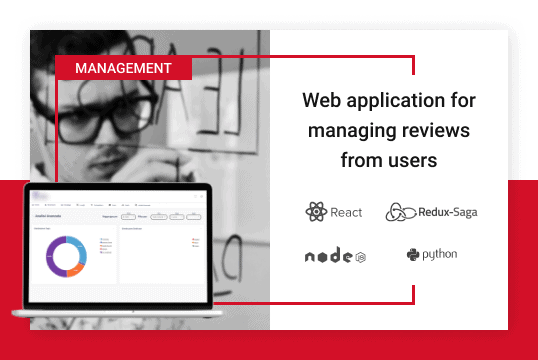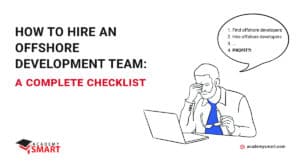What is Staff Augmentation: Meaning, Benefits, Trends
In this article, we intend to explain the meaning of staff augmentation and demonstrate why this workforce management model is convenient and beneficial for the customer.
Modern market realities require businesses to respond promptly to the challenges of digitizing processes, so immediate access to qualified personnel from the IT sphere is of particular value.
Indeed, the need for a variety of IT professionals is steadily growing. According to a report by GVR, the market for professional IT services is projected to grow from $821.58 billion in 2022 to $1,921.33 billion by 2030. A growth rate is expected to be more than 11%, even when the effects of the economic recession are considered. At the same time, many developed countries are already experiencing a shortage of qualified employees in robotics, artificial intelligence, the Internet of Things, blockchain, and other technologies.
On the other hand, not all companies can afford fully staffed IT departments due to the high cost of local specialists or their absence. That is why alternative ways of staff augmentation, which we’ll discuss below, are one of the trends in IT development in common.
What is staff augmentation in IT
Filling existing positions with remote employees is the essence of what is staff augmentation in practice. Suppose we have a certain lack of labor resources. In that case, we turn to where these resources are available and get the necessary skills and knowledge at our disposal as much as we need them — doing so, we save a lot of time on finding the right IT talent and administrative resources for hiring them.
An augmentation service provider usually handles both. All you have to do is specify your needs to the expertise and skill level of the future employee, and the agency will offer you an interview with suitable candidates according to the selection criteria.
Expanded definition of staff augmentation
You may have already noticed that IT staff augmentation, as a business strategy, somewhat changes the traditional approach to hiring employees, adding flexibility and variability to the process.
It is important to note that staff augmentation should be understood as more than just a quantitative increase in the number of employees. On the contrary, the qualitative reinforcement of your department brings the best results in the shortest amount of time. One specialist with strong hard skills in his\her field can be worth an entire unit of newcomers. And the money you pay for his time on your project will save many hours of work on the product without him.
Another indisputable advantage of the IT staff augmentation model is its scalability. On-demand, you can bring in individual employees as consultants, executives, or technical managers at various project stages. However, it includes the possibility of involving on the project or its part an entire software development team, if necessary. In other words, staff augmentation can be considered a specific form of outsourcing with the options of fine-grained labor management and complete control over the project work. We’ve already covered that in detail in the article Outsourcing vs Outstaffing: What To Choose, so here we’ll summarize it in general.
Types of staff augmentation
What are the main models of staff augmentation in IT?
Project-based cooperation
The most traditional approach to organizing work with remote staff is usually called IT outsourcing. In this case, a contracting company or a particular IT specialist freelancer takes responsibility for the work on the project. The customer gives a detailed description of the required service or software product and then receives periodic reports on the project’s progress. As a rule, the customer does not influence who exactly the contractor involves in the project. And the communication between the customer and the contractor’s engineering team is mediated by the project manager, who represents the team.
It is an excellent way to get a quick start on a project, especially if you don’t have your IT team and technical background. The client’s worries about staffing and maintenance are minimized. On the other hand, the customer’s control over the work processes is somewhat limited. And to a large extent, he has to rely on the competence and integrity of the outsourcer-contractor.
Dedicated team
A similar mechanism of the IT staff augmentation through a remote outsourcing team is inherent in the dedicated team model. There is one significant difference: in this case, the developers act as a remote IT department of the company, participating in all of the customer’s projects and managing the work of subcontractors. In other words, it implies long-term, large-scale cooperation not limited by a specific task.
Despite a certain autonomy of the dedicated team, more direct communication with the client than that of project-oriented outsourcers contributes to a closer relationship and a better understanding of the client’s needs.
It is a great way to reduce the cost of office space and the tax burden on your company. At the same time, the odds of building a long-term and productive relationship with your freelance outsourced employees are high.
Extended team
Augmenting your staff with remote employees of a particular specialization is the most flexible and manageable form of interaction with IT-outsourcers. In this case, you directly decide what competencies and skill levels you wish to acquire to strengthen the capabilities of your in-house team. You have the opportunity to interview candidates and select the most suitable employee.
Another obvious advantage of this model, otherwise known as outstaffing, is total control over the remote employee’s work. In the case of unsatisfactory results, you can always replace him. Of course, when the demand for his services is exhausted, you can easily exclude him from the team.
It is the best option to quickly get IT specialists with the qualifications your team lacks and be aware of how these specialists perform their duties.
Examples when to use staff augmentation services
Indeed, it is hard to imagine a situation where a project-oriented model of HR management could not solve the task, especially since IT talents are selected for it by the outsourcer itself by default. So, let’s look at the most typical cases of the practical application of a person-centered IT staff augmentation model, in which the initiative belongs to the customer.
Working hands are needed
Let’s say you have your own IT department or dedicated team, but you see that it cannot cope with the number of routine tasks. Yes, you have a fully debugged workflow, all processes and procedures are set up, and no special knowledge and skills are required for such work. However, an extra couple or three average programmers, testers, database analysts, or DevOps will significantly reduce the load on the full-time employees, eliminate overwork and improve the department’s overall efficiency.
Competencies needed
While working on your project, you need specialists in some technology stacks, or your product requires exclusive knowledge and engineering skills. At the same time, it turns out that the services of native specialists in this field are very high, or there is no available talent nearby.
The cost of services from offshore development companies is usually much lower than that of their colleagues in the West. You can find IT specialists with the right expertise from outsourcers. Some valuable tips on how to best expand your staff with offshore developers have been highlighted in our article How to Hire an Offshore Development Team: A Complete Checklist.
Having a software engineer with solid hard skills on your team often leads to streamlined workflows and can also provide new insights into solving existing problems.
Effective communication is needed
Do you enjoy active participation in project management and direct coordination of work issues with your team? Do you think the work of project teams is not transparent and would like to see the results directly? Then you need to know what staff augmentation means in practice: remote specialists will always be ready to talk to you during working hours, offer their solution to a problem and provide a report on the work done.
You need to solve a problem quickly
This service is one of the leading trends in the IT industry because it allows the customer to solve the problem of staff augmentation in the shortest possible time. Since outstaffing companies are constantly searching for new talents in a wide range of fields, in most cases, they already have someone to offer at the moment of the client’s request. Even considering all the client’s wishes, competent employees can be hired within a week. Therefore, offshore outstaffing is a smart and effective solution if time is of the essence.
Pros & Cons of Staff Augmentation
As practice shows, the benefits of staff augmentation make this outsourcing model attractive to businesses, whether a startup or a multinational corporations of global renown. First, offshore staff augmenting combines optimally outsourcing personnel and work in a usual working schedule because the remote employees are always in touch. What else is good about the IT staff augmentation?
Pros
- You significantly save time and money on finding the right professionals. Instead of searching for the talents you need on freelance markets, online professional platforms, or by advertisement, you use the IT outsourcing company’s staff that has already been selected and proven many times in action. You also don’t have to spend money on the work of a recruiting agency or on training in-house staff if their skill level is insufficient. Outsourcers look for various specialists on their own and are constantly attracting new talent to their ranks.
Using the IT staff augmentation, you are insured against having random people come in for interviews which do not have the qualifications your project requires. The outstaffer company takes a detailed look at what you want in terms of the technology stack and the skill level of the candidates. If you need a senior specialist, the agency will not offer you a middle, much less a junior, because they value their reputation. Also, by interviewing applicants directly, you can always choose those whose teamwork, and English language skills seem better. - You definitely save on workspace organization, office space, furniture, and PCs, since a remote worker does not need them. You also avoid the costs associated with employee payroll and taxation since this issue is handled by an outsourcing company that is likely a resident of another country.
- It may not be so obvious, but the money you pay for hiring a specialist from an offshore country, including the outstaffer company’s fee, is considerably less than you could spend on a similar specialist from any Western country. The low standard of living in offshore countries is the main reason for the lower hourly labor rates. But this in no way affects the quality of work of an extended team member and the responsible attitude to it. Additionally, qualified augmented staff quickly step in, often adding value to a project with a fresh perspective on its problems.
- Using the staff augmentation model frees you from geographic boundaries, giving you access to various specialists in many fields, including the most unique. You will find specialists in both rarities and cutting-edge technologies, and you will be able to take advantage of their expertise rather quickly.
- You can manage your workforce with maximum flexibility, adding human resources as needed and scaling up and down as your project needs evolve. You see the results of your augmented staff and you can replace bad employees at any time. You don’t need to worry about formal hiring and firing of employees – this is an internal matter of the outstaffer company. Entrust your HR routine to professionals, and you can focus directly on your business’s challenges.
Cons
- Working with people from other countries, we encounter cultural and mental differences that can sometimes affect the work process in unpredictable ways. Of course, poor mastery of an international language, English, for example, can also exacerbate misunderstandings, causing tensions within the extended team. The considerable remoteness of the offshore country also leads to a noticeable time difference, which doesn’t help to synchronize work efforts.
Experienced clients prefer to deal with outstaffers from culturally close countries to minimize this likely disadvantage. A customer from Western Europe or North America would be more comfortable working with IT professionals from Eastern Europe, such as Ukraine, and a customer from Japan – with Vietnamese or Chinese contractors. - Some projects require specific institutional knowledge, so it can take a considerable time for even the top IT professionals to understand the context. Well, this is an inevitable consequence for any narrowly focused project. Even an effective, usually staff augmentation model can’t accelerate mastering the necessary minimum of knowledge to work on a project entirely.
- No outstaffing company can have specialists in all current areas of the IT industry. Of course, every severe organization will make all possible efforts and connections to help its client get a professional with the necessary qualification. However, in some cases, searching for a suitable expert may take longer than planned. In addition, there may be a specific dependence on third-party organizations and their terms of cooperation, which may also slightly adjust the initial plans.
- Depending on the relationship structure between the client team and augmented staff, there may be mediating links in the communication. It is often seen in the case of a combination of dedicated and extended team models, where current staffing is insufficient, and specific IT specialists from outside are required. However, other variations are also possible when coordination of efforts is not well-established on both the client and outstaffing contractor side.
The increased complexity of the structure, of course, affects the speed of communication and decision-making in general. The only advice here is to find your balance and stick to it. - If in the case of traditional outsourcing you don’t care at all about selecting employees for the project team, you may need a technical background or a qualified technical consultant capable of assessing applicants’ skills to select outstaffers properly. Although an IT outsourcer usually meets the client’s needs the first time, there are still unfortunate lapses on both sides. To exclude an unplanned waste of time, this may be worth considering.
- The involvement of third parties in a project is always fraught with risks to data security and commercial confidentiality. Pay special attention to how the company providing IT staff augmentation services regulates the behavior of its employees in the security field, and you will be able to prevent possible threats.

An example is how Academy Smart’s team participated in a client application update
How to choose the right staff augmentation model
Well, now you have a clear idea of what is staff augmentation model and how you can benefit from it. All we have to do is figure out how to use the strengths of this approach to achieve your business goals.
1. Define your goals
It’s essential to understand what you’re going to expand your staff for to choose the suitable model for working with a contractor. Evaluate your available resources, both labor and financial. Find out which specialists of what technology stack you need and in what quantity. Feel free to consult with technical specialists. Also, pay attention to the planned duration of cooperation with outside workers.
If you need a final product or a one-time service of IT specialists to maintain or upgrade a software product, the best solution is to outsource this task. The company provider will assemble a team of competent developers, organize the workflow, and guide you from idea to finished product with minimum time spent on routine.
If you are planning a long-term collaboration but are still deciding whether to open your own IT department, the dedicated team format is the best solution to try out your ideas in practice. You can implement the gained experience in the in-house staff later.
If your department requires reinforcement or additional competencies, including leadership, staff augmentation in IT outstaffing form will be a reasonable and cost-effective choice.
2. Choose the right offshore area
For the cooperation to be beneficial and synchronized, consider the advantages and disadvantages of potential collaboration with offshore developers from different countries and exclude those options which might be doubtful.
Optimal relationships in an extended team are formed between mentally close people who share common values and perspectives on the work culture. One of the best offshore countries for Europe and America is Ukraine, as proven by years of practice, including Academy Smart.
3. Make a list of vendors you trust
In social networks and specialized online review platforms like Clutch, read the feedback about companies providing outsourcing and outstaffing services. Examine the candidates’ portfolios and talk to their former clients to understand the prospects for real cooperation. Limit your choice to a dozen companies that meet your requirements.
4. Interview candidates and hire the best ones
Reach out to the company to get answers on how it can help you achieve your goals. See if they have the right people and how quickly they can get to work on your project. Listen carefully to suggestions and objections regarding remote working. Consistently screen out vendors that cannot meet your needs or are suspicious.
Once you have found a company you like, request a list of applicants to join your team and interview them to shortlist the best candidates. Once you’ve decided on the personalities, sign the contract, and accept new hires into your department.
5. Stay in touch
Once remote employees have assumed their duties, stay in touch with the vendor’s managers to resolve ongoing co-op complexities promptly. Remember that you can refuse the services of a specialist who is unsuitable for you or is no longer required. At the same time, the outsourcing company will try to replace the retired specialist or add new employees on demand.
To summarize, the demand for IT staff augmentation service is based on its cost-effectiveness, adaptability and high performance. If you are looking for a company you can trust to bring your ideas to life, look at Academy Smart’s portfolio. Our years of experience are your reliable companion on the road to success. Feel free and get in touch to discuss details.
Staff augmentation: Frequently Asked Questions
What is staff augmentation in IT?
Staff augmentation is an effective way to solve the problem of labor shortages by attracting remote IT specialists. Professional IT companies provide outsourcing and outstaffing services, covering customer needs for qualified specialists.
What are the benefits of staff augmentation?
- Saving Resources
- Freedom from hiring routine
- Access to a rich pool of IT-pros
- Flexibility and scalability
- Process manageability


